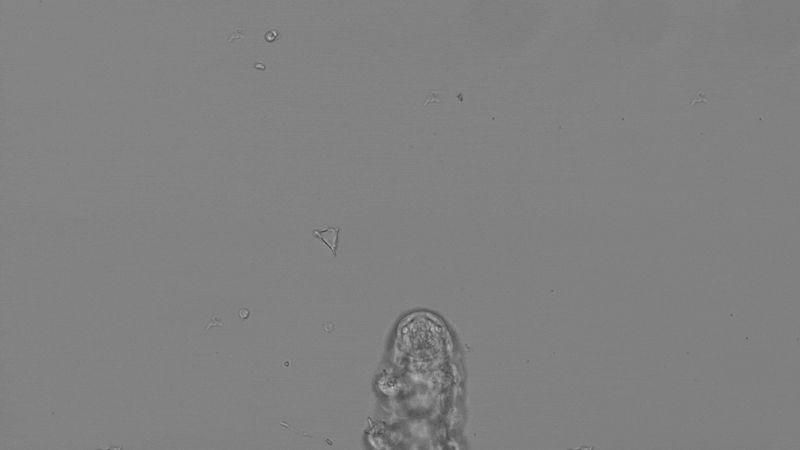
Tiny, squishy, water bears walk just like insects 500,000 times their size
By
on
The new study, published online Aug. 31 in the Proceedings of the National Academy of Sciences, is the first investigation into the mechanics of how water bears walk. Exactly how they developed this insect-like gait is still unknown, but the new understanding may help scientists develop miniature or soft-bodied robots that walk.
“We thought water bears might have an uncoordinated gait because the media has portrayed them as slow and clumsy critters, or that they would have some really wacky patterns because they are so small and needed different strategies,” said Daniel J. Cohen, an assistant professor of mechanical and aerospace engineering and senior author of the study. “And then it turns out they happily charge along, doing something remarkably similar to creatures 500,000 times larger than they are.”
Water bears are eight-legged animals, the size of a few strands of hair, that live almost everywhere on Earth they can find water. Despite their aquatic lifestyle, they are poor swimmers and walk more like land animals. Their official name, tardigrade, means “slow stepper.” The hardy animals can survive radiation, starvation and freezing temperatures and endure almost complete dehydration by entering a state of suspended animation. Walking may represent a vital survival skill for water bears because it allows them to seek out damp environments or find slowly drying spots that let them transform into their dormant state.

In their standard stepping pattern, water bears move diagonal pairs of legs, one set at a time, as shown in this underside view of a water bear.
Illustration by Neil Adelantar from an image by Nirody et al.
Cohen collaborated with Jasmine Nirody, an independent joint fellow at Rockefeller University and Oxford University who specializes in animal locomotion to investigate how water bears walk. The two researchers met as graduate students at the University of California, Berkeley and have since been waiting for an opportunity to study these fascinating creatures.
As perhaps the smallest animal with legs, water bears face unique challenges to walking. “We know a lot about how larger things walk, but when things get really small, the physics of their interactions with the environment naturally change a lot,” said Nirody. “At their size, they are fighting the viscous forces of water. It’s like if we were walking through honey or peanut butter.”
Also, water bears have neither the internal skeleton of a mammal, nor the rigid exoskeleton of an insect. Animals use their skeletons to push off the ground and propel themselves forward. Instead, water bears use their claws like grappling hooks. When they can’t gain traction, like in this video of a water bear on a glass microscope slide, they just flail—ironically, waterbears cannot swim.
To figure out how water bears get around, co-authors Lisset Duran, a graduate student in molecular biology, and Deborah Johnston, a former high school student now at the University of Rochester, raised a species of water bear typically found on wet moss. They placed the animals under the microscope on a thick gel that they could dig their claws into and recorded hundreds of hours of water bears ambling by at about one-third of an inch per minute. The entire team pitched in to track the water bears’ footsteps on the videos, and Nirody analyzed the results to develop a model of their stepping patterns.
Water bears use their front six legs to walk, moving diagonal pairs of legs, one set at a time, in a pattern that is surprisingly similar to stick insects. To go faster, they simply let each foot rest on the ground for less time in between steps. The stepping pattern remains the same regardless of speed, so the researchers suspect that a single neural circuit controls this behavior.
When the researchers placed the water bears on a softer gel, they were surprised to see them switch from stepping to galloping. They had to coordinate all their legs simultaneously to move across the squishy ground. “Interestingly, that kind of coordination scheme was recently characterized in a desert-dwelling beetle that moves on shifting sand,” said Nirody.
There are two potential explanations for why water bears walk in this completely familiar, not-at-all clumsy way. One possibility is that they inherited the neural circuit that controls the stepping pattern from a common ancestor they share with insects. Water bears are cousins to the arthropods—the wildly successful group that includes insects, millipedes, crustaceans and spiders. Another possibility is that both groups independently evolved the same walking strategy, even though they live in vastly different environments and scales.
“We can’t answer that from this study, but it seems like it’s one of those two things, which is pretty neat either way,” said Cohen.
“It’s a very nice paper – I’m jealous I didn’t do it!” said Daniel Goldman, the Dunn Family Professor of Physics at the Georgia Institute of Technology. “I am fascinated by the questions it raises regarding the neural circuits and mechanics that control these gaits, and why these animals use the diverse gaits they do.”
These findings may be useful for engineering new types of robots. Soft-bodied robots are more flexible and adaptable that rigid ones, but scientists know less about how to control them. The work also suggests it’s possible to build microrobots at that scale that move around on legs rather than by swimming.
For the next steps, Cohen wants to study how water bears generate forces and use their claws in the hopes of bio-inspired solutions to future microbots. Nirody is interested in how the water bears adapt their walk to different conditions, like scaling an incline or traversing a rough surface. She also hopes to investigate other species. “There are about 1,000 species of tardigrades out there,” she said. “I would expect that there are some interesting adaptations in the marine and freshwater ones that we haven’t yet seen.”
Funding for this project came from a School of Engineering and Applied Science Innovation Grant from the Helen Shipley Hunt Fund. Co-authors on the paper received support from the James S. McDonnell Foundation, the University of Oxford, Rockefeller University, and a Jonas Salk Award.







